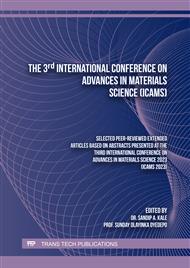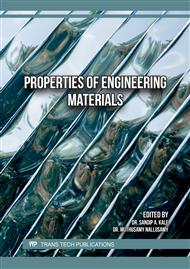[1]
O. Faruk, A. K. Bledzki, H.-P. Fink, and M. Sain, "Biocomposites reinforced with natural fibers: 2000–2010," Prog. Polym. Sci., vol. 37, no. 11, p.1552–1596, Nov. 2012.
DOI: 10.1016/j.progpolymsci.2012.04.003
Google Scholar
[2]
V. K. Balla, K. H. Kate, J. Satyavolu, P. Singh, and J. G. D. Tadimeti, "Additive manufacturing of natural fiber reinforced polymer composites: Processing and prospects," Composites Part B: Engineering, vol. 174, no. May. Elsevier Ltd, p.106956, Oct. 2019.
DOI: 10.1016/j.compositesb.2019.106956
Google Scholar
[3]
V. Mazzanti, L. Malagutti, and F. Mollica, "FDM 3D Printing of Polymers Containing Natural Fillers: A Review of their Mechanical Properties," Polymers (Basel)., vol. 11, no. 7, p.1094, Jun. 2019.
DOI: 10.3390/polym11071094
Google Scholar
[4]
E. Zini and M. Scandola, "Green composites: An overview," Polym. Compos., vol. 32, no. 12, p.1905–1915, Dec. 2011.
DOI: 10.1002/pc.21224
Google Scholar
[5]
R. Auras, L. T. Lim, S. E. M. Selke, and H. Tsuji, Poly(Lactic Acid). Hoboken, NJ, USA: John Wiley & Sons, Inc., 2010.
DOI: 10.1002/9780470649848
Google Scholar
[6]
V. Mazzanti and F. Mollica, "Rheological behavior of wood flour filled poly(lactic acid): Temperature and concentration dependence," Polym. Compos., 2019.
DOI: 10.1002/pc.24559
Google Scholar
[7]
V. Sekar, M. H. Fouladi, S. N. Namasivayam, and S. Sivanesan, "Additive Manufacturing: A Novel Method for Developing an Acoustic Panel Made of Natural Fiber-Reinforced Composites with Enhanced Mechanical and Acoustical Properties," J. Eng., vol. 2019, p.1–19, Sep. 2019.
DOI: 10.1155/2019/4546863
Google Scholar
[8]
Q. Zhang, L. Shi, J. Nie, H. Wang, and D. Yang, "Study on poly(lactic acid)/natural fibers composites," J. Appl. Polym. Sci., vol. 125, no. S2, pp. E526–E533, Sep. 2012.
DOI: 10.1002/app.36852
Google Scholar
[9]
S. Wickramasinghe, T. Do, and P. Tran, "FDM-Based 3D Printing of Polymer and Associated Composite: A Review on Mechanical Properties, Defects and Treatments," Polymers (Basel)., vol. 12, no. 7, p.1529, Jul. 2020.
DOI: 10.3390/polym12071529
Google Scholar
[10]
A. Le Duigou, D. Correa, M. Ueda, R. Matsuzaki, and M. Castro, "A review of 3D and 4D printing of natural fibre biocomposites," Mater. Des., vol. 194, p.108911, Sep. 2020.
DOI: 10.1016/j.matdes.2020.108911
Google Scholar
[11]
B. Madsen, A. Thygesen, and H. Lilholt, "Plant fibre composites - porosity and stiffness," Compos. Sci. Technol., 2009.
DOI: 10.1016/j.compscitech.2009.01.016
Google Scholar
[12]
N. Krajangsawasdi, L. G. Blok, I. Hamerton, M. L. Longana, B. K. S. Woods, and D. S. Ivanov, "Fused deposition modelling of fibre reinforced polymer composites: A parametric review," Journal of Composites Science, vol. 5, no. 1. MDPI, p.29, Jan. 16, 2021.
DOI: 10.3390/jcs5010029
Google Scholar
[13]
V. Dahmen, A. J. Redmann, J. Austermann, A. L. Quintanilla, S. J. Mecham, and T. A. Osswald, "Fabrication of hybrid composite T-joints by co-curing with 3D printed dual cure epoxy," Compos. Part B Eng., vol. 183, p.107728, Feb. 2020.
DOI: 10.1016/j.compositesb.2019.107728
Google Scholar
[14]
R. Kussmaul et al.,"Combining additive manufacturing and carbon fiber patched composites for and sustainable biomedical applications," in ECCM 2018 - 18th European Conference on Composite Materials, 2020, no. June.
Google Scholar
[15]
T. Daniel-Alexander, Z. Andreas, K. Christoph, and M. Mirko, "Combining additive manufacturing with CFRP composites: Design potentials," in Proceedings of the International Conference on Engineering Design, ICED, 2015, vol. 4, no. DS 80-04, p.279–290.
Google Scholar
[16]
D.-A. Türk, L. Triebe, and M. Meboldt, "Combining Additive Manufacturing with Advanced Composites for Highly Integrated Robotic Structures," Procedia CIRP, vol. 50, p.402–407, 2016.
DOI: 10.1016/j.procir.2016.04.202
Google Scholar
[17]
K. G. J. Christiyan, U. Chandrasekhar, and K. Venkateswarlu, "A study on the influence of process parameters on the Mechanical Properties of 3D printed ABS composite," IOP Conf. Ser. Mater. Sci. Eng., vol. 114, no. 1, p.012109, Feb. 2016, doi: 10.1088/1757-899X/ 114/1/012109.
DOI: 10.1088/1757-899x/114/1/012109
Google Scholar
[18]
J. M. Chacón, M. A. Caminero, E. García-Plaza, and P. J. Núñez, "Additive manufacturing of PLA structures using fused deposition modelling: Effect of process parameters on mechanical properties and their optimal selection," Mater. Des., vol. 124, p.143–157, Jun. 2017.
DOI: 10.1016/j.matdes.2017.03.065
Google Scholar



